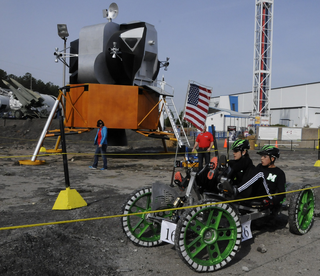Apr 20 2015
Buckle up, because it’s back… two days of intense student racing kicks-off April 17-18 for the annual NASA Human Exploration Rover Challenge.
 A student team roves across a simulated alien landscape during the 2014 NASA Human Exploration Rover Challenge in Huntsville, Alabama. Credits: NASA/MSFC/Emmett Given
A student team roves across a simulated alien landscape during the 2014 NASA Human Exploration Rover Challenge in Huntsville, Alabama. Credits: NASA/MSFC/Emmett Given
This competitive international design challenge boasts 95 registered university/college and high school teams, hailing from 18 states, Puerto Rico and from as far away as Mexico, Germany, India and Russia. Each team has spent months designing, building and testing their rovers, all for this moment…to roll into the U.S. Space & Rocket Center in Huntsville, Alabama, to defend their crowns or usurp the hierarchy of previous winners.
Rover Challenge requires student teams to design, construct, test and race human-powered rovers through an obstacle course simulating terrain potentially found on distant planets, asteroids or moons. Teams race against the clock to finish the course with the fastest times, vying for prizes in competitive divisions. The event concludes with an awards ceremony where corporate sponsors will present awards for best design, rookie team and other awards and accomplishments.
The nearly three-quarter-mile-long obstacle course will have teams racing and maneuvering in, through and around full-size exhibits of rockets, space vehicles and extra-terrestrial terrain on display at the U.S. Space & Rocket Center– the official visitor center of NASA’s Marshall Space Flight Center in Huntsville. All races will be from 7:30 a.m. to 4 p.m. CDT and open to the public for viewing, as well as broadcast live on NASA TV and Marshall’s Ustream page.
The course continues to feature the lunar-themed obstacles of years past, but with a new twist -- the addition of Martian-themed obstacles highlighting NASA’s future goals of deep-space exploration. This year’s course includes 17 unique obstacles built from wood, aluminum, rubber tires and tons of gravel, sand and red clay. The material is carefully shaped to resemble craters, basins, boulders, ancient lava flows, crevasses and other obstacles. The course features simulated fields of asteroid debris -- boulders from 5 to 15 inches across; an ancient stream bed filled with pebbles about 6 inches deep; and erosion ruts and crevasses in varying widths and depths.
Marshall’s Academic Affairs Office manages the Rover Challenge, which was inspired by the Lunar Roving Vehicles of the Apollo moon missions and managed by Marshall engineers. The event is designed to teach students to solve engineering problems, while demonstrating NASA's commitment to inspire new generations of scientists, engineers and explorers.
"For 21 years, we have welcomed talented students, each more excited than the last to share their knowledge and enthusiasm," says Tammy Rowan, manager of Marshall’s Academic Affairs Office. "Students in this difficult, yet rewarding NASA challenge demonstrate the real-world skills needed to pursue their educational and career goals.”
Veteran teams and first-year rookies have prepared for this event by employing the latest in high-tech software and hardware. This includes using 3D printing, computer-aided designs, selecting and fabricating components using mechanical tools and rigorous testing of innovative technologies in a variety of environments.
Teams will arrive in Huntsville April 16 for on-site registration. Nonstop media coverage will be provided on Marshall’s Ustream webpage, Twitter account and NASA TV. The awards ceremony will be April 18 at 5 p.m., at the Davidson Center for Space Exploration in Huntsville. The ceremony will also be broadcast on Ustream.